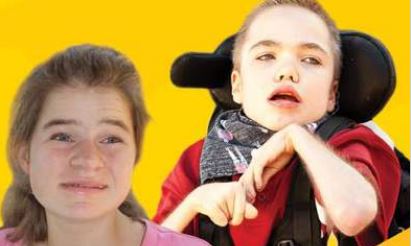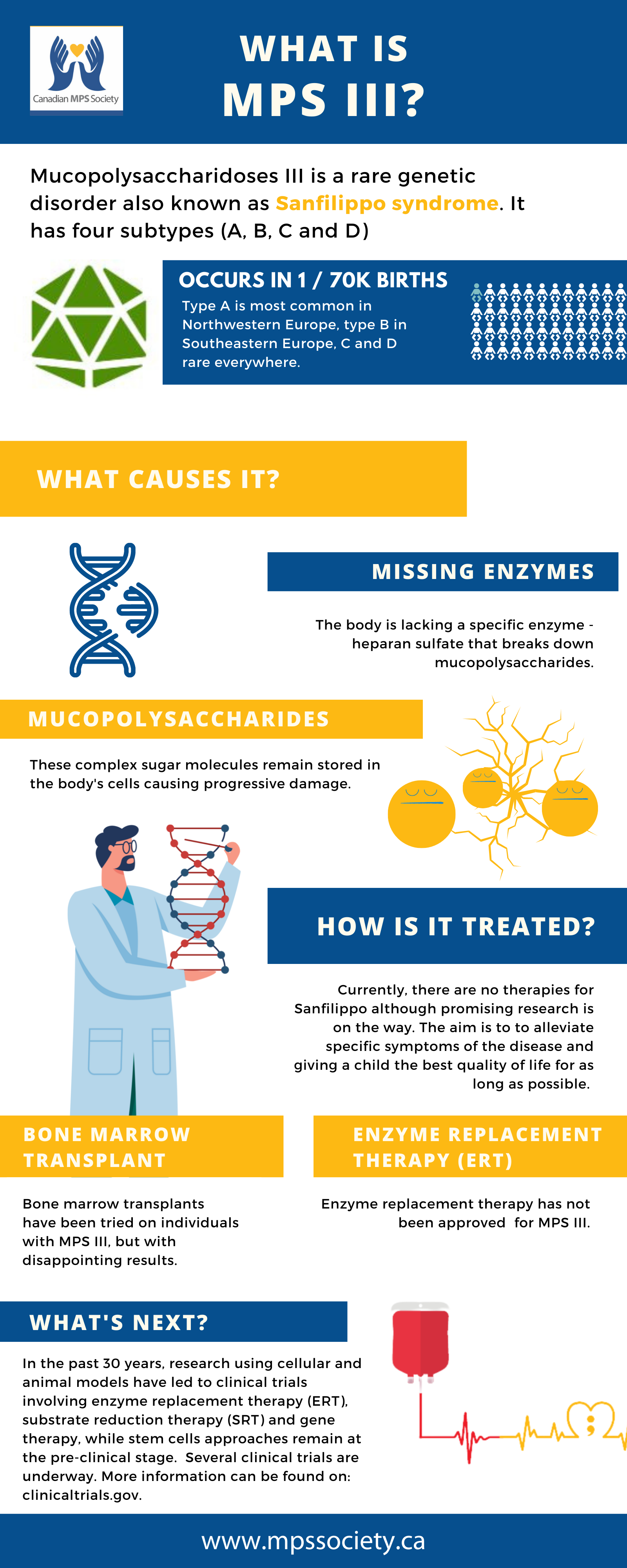
Quick Facts
What is MPS III (Sanfilippo Syndrome)?
MPS III is a mucopolysaccharide disease also known as Sanfilippo syndrome. It takes its name from Dr. Sylvester Sanfilippo, who was one of the doctors in the United States who described the condition in 1963.
What causes this disease?
Mucopolysaccharides are long chains of sugar molecule used in the building of connective tissues in the body.
- “saccharide” is a general term for a sugar molecule (think of saccharin).
- “poly” means many
- “muco” refers to the thick jelly-like consistency of the molecules
There is a continuous process in the body of replacing used materials and breaking them down for disposal. Children with these diseases are missing an enzyme which is essential in breaking down the mucopolysaccharides called dermatan sulfate and heparan sulfate.
This disease has four subtypes (A, B, C and D). Each subtype corresponds to a lack of a different enzyme, each one responsible for a different step of breaking down heparan sulphate. The incompletely broken down mucopolysaccharides remain stored in part of the cells called the lysosome, in the body causing progressive damage. Babies may show little sign of the disease, but as more and more cells become damaged, symptoms start to appear.
How common are these diseases?
The incidence of MPS III (all four types combined) is estimated to be 1 in 70,000 births. Type A is the most common one in Northwestern Europe, type B in Southeastern Europe, and types C and D are rare everywhere.
Are there different forms of this disease?
To date, four different enzyme deficiencies have been found to cause MPS III, described as type A, B, C or D.
There is usually very little difference between the four types of the disease, but there have been some very mild cases of the B form where the affected individuals have remained relatively healthy into adult life.
How is the disease inherited?
We all have genes inherited from our parents which control whether we are tall, short, fair, etc. Some genes we inherit are “recessive,” that is to say we carry the gene but it does not have any affect on our development. MPS III is caused by a recessive gene.
If the adult carrying the abnormal gene marries another carrier there will be a one in four chance with every pregnancy that the child will inherit the defective gene from each parent and will be affected with the disease.
There is a two in three chance that unaffected brothers and sisters of MPS III patients will be carriers. They can be reassured, however, as the disease is so rare, the chance of marrying another carrier is very slight provided they do not marry a cousin or other close family member.
How does the disease progress?
The disease will affect children differently, and its progress will be much faster in some individuals than in others. Change will usually be very gradual, and therefore, easier to adjust to.
Sanfilippo mostly affects the brain and is one of a group of conditions called ‘childhood dementia’. The child’s pre-school years may be a very frustrating stage for the parents. They begin to worry as their child starts to lag behind their friends’ children in development, and they may feel they are being blamed for the child’s overactive and difficult behavior.
The diagnosis is often made very late as some children do not look abnormal, and their symptoms are among the most common seen in all children. The doctor has to be perceptive enough to recognize that something serious is wrong and ask for urine and blood tests to help reach a diagnosis. It is not unusual for families to have one or more affected children before the diagnosis is established. Some children are extremely active and restless with very difficult behaviour. Some children sleep very little at night. Many will be into everything. Many like to chew: hands, clothes or anything they can get hold of.
Sadly, language and understanding will gradually be lost and parents may find it hard not being able to have a conversation with their child. Many will find other ways of communicating. Some children never become toilet trained, and those who do will eventually lose the ability.
As children with MPS III syndrome get older, they begin to slow down. They become unsteady on their feet, tending to fall frequently as they walk or run. Eventually they lose the ability to walk. Life may be more peaceful in some ways, but parents will need help with the physically tiring task of caring for an immobile child or teenager.
All families of affected children should seek further information from their doctor or from a Genetic Counselor.
Is there a cure?
At present there is no cure for any of the mucopolysaccharide diseases.
Enzyme replacement therapy (ERT)has been approved by the FDA for several of the MPS diseases, but not yet for MPS III.
BMN 250 is an investigational enzyme replacement therapy being developed to treat Sanfilippo B Syndrome. For more information see clinicaltrials.gov.
Bone marrow transplants have been tried on individuals with MPS III, but with disappointing results.
Gene therapy, chaperone therapy and intrathecal enzyme therapy are a few of the treatments for MPS III where research is ongoing.
Clinical Care Guidelines For Sanfilippo Syndrome
The first-ever global consensus clinical care guidelines for Sanfilippo syndrome have been published by The Cure Sanfilippo Foundation. These guidelines provide guidance on Sanfilippo syndrome-specific care management and monitoring of disease-related changes.
Access The Clinical Care Guidelines For Sanfilippo Syndrome on the curesanfilippofoundation.org website.
Back to All Types of MPS >

